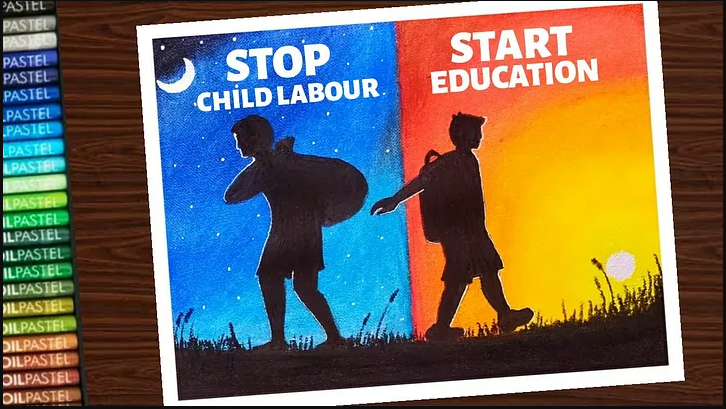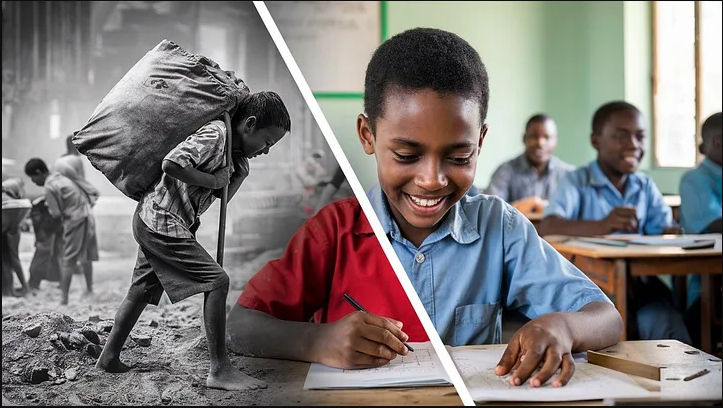Introduction: Understanding the Link Between Child Labor and Poverty
Child labor and education
Child labor remains a global issue, trapping millions of children in a cycle of poverty and lost opportunities. Despite growing awareness and intervention efforts, countless children are still forced into work instead of attending school. This situation not only robs them of their childhood but also their future. Education is the most effective weapon in the fight against child labor—it equips children with the knowledge and skills to escape poverty and build better lives.
The Harsh Reality of Child Labor
Child labor affects more than 160 million children worldwide, particularly in low-income countries. These children often work in hazardous environments—factories, farms, mines, and domestic settings—under dangerous and exploitative conditions. Most work long hours for little or no pay, with no access to education or basic rights.
Poverty is the root cause. Families struggling to survive may rely on their children’s income just to meet daily needs. Unfortunately, this short-term solution has long-term consequences, as it keeps children out of school and limits future employment prospects.
Why Education Is the Key to Ending Child Labor
Education plays a crucial role in breaking this vicious cycle. When children attend school, they are protected from exploitation and gain the tools they need to improve their lives. Literacy, critical thinking, and vocational training open up opportunities for decent employment as adults.
Moreover, educated individuals are more likely to escape poverty, support their families, and invest in the next generation’s education. It’s a cycle of empowerment that starts with access to quality learning.
Benefits of Education in Combating Child Labor
Protection from Exploitation: Schools provide a safe environment where children are less vulnerable to being recruited into labor.
Economic Mobility: Education equips children with marketable skills that lead to higher-paying jobs in the future.
Empowerment and Awareness: Learning helps children understand their rights and advocate for themselves and others.
Community Development: A more educated population leads to stronger economies and reduced dependence on child labor.
Barriers to Education for Vulnerable Children
While the benefits are clear, access to education remains a challenge for many. Barriers include:
Poverty and Financial Constraints: Families often can’t afford school fees, uniforms, or supplies.
Lack of Infrastructure: In rural or conflict-affected areas, schools may be far away, understaffed, or nonexistent.
Cultural Norms and Gender Disparities: In some regions, boys are prioritized over girls when it comes to education.
Child Labor Itself: Working children may not have the time or energy to attend school regularly.
These challenges require comprehensive solutions that address both the economic and social factors contributing to child labor.

Effective Strategies to Eliminate Child Labor Through Education
Tackling child labor isn’t a one-step solution—it demands a layered strategy that weaves together strong laws, access to quality education, and active involvement from local communities. Each piece is vital. Without one, the others falter. It’s not just about banning the practice; it’s about building a system where children have real alternatives and support to thrive.
Free and Accessible Quality Education
Governments and NGOs must work together to ensure free, compulsory primary and secondary education. This includes providing school materials, meals, and transportation in remote areas. Quality must also be a focus—well-trained teachers, updated curricula, and safe learning environments are essential.
Conditional Cash Transfers and Incentives
Programs that provide financial support to families who send their children to school have proven effective. These incentives help offset the income lost from child labor and encourage consistent school attendance.
Community Awareness and Advocacy
Educating communities about the value of education and the risks of child labor can shift mindsets. Local leaders, teachers, and parents must be involved in promoting school enrollment and holding institutions accountable.
Legal Frameworks and Enforcement
It’s essential to firmly uphold child protection laws and labor regulations—these safeguards aren’t optional. They exist to shield the most vulnerable from exploitation, and without strict enforcement, they lose all meaning. Every child deserves a safe, fair start in life, and that begins with accountability.Employers exploiting children should face legal consequences, and governments must monitor labor practices across industries.
Vocational and Non-Formal Education Programs
For older children or those who missed formal education, vocational training provides an alternative route. Skills-based learning empowers them to pursue livelihoods that do not depend on exploitative labor.
Success Stories: Education as a Catalyst for Change
In countries like Brazil and Bangladesh, investments in education have significantly reduced child labor rates. Brazil’s Bolsa Família program, which ties financial aid to school attendance, has helped millions stay in school. Similarly, Bangladesh has implemented successful stipend programs that particularly support girls’ education, reducing dropout rates and child marriage.
These examples show that when education is prioritized, real progress can be made in the fight against child labor.
Breaking the cycle of child labor and poverty is not a distant dream – it is a tangible goal that begins with education. Every child is capable of learning, thriving, and participating in society. It is the responsibility of governments, communities, and global citizens to ensure that education is not a privilege for a few, but a right for all.
By investing in education today, we lay the foundation for a brighter future, a better tomorrow. Let’s work together to make schools safe havens and a stepping stone for every child, ending child labor forever.
Keywords: child labor, education, poverty cycle, child rights, global development, vocational training, school access, financial aid, child protection laws, quality education, youth empowerment









